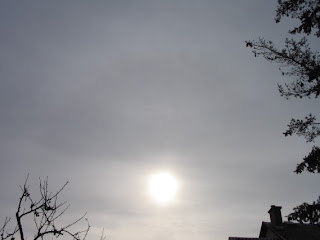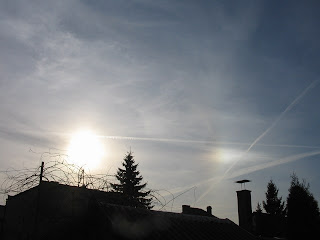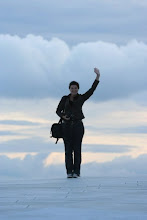Kedves met.net-esek! Mivel látom, hogy felfedeztétek az oldalt (és mivel ma sem sikerült semmit lefotóznom), itt küldök külön Nektek még egy kis régi légköroptikát. Ezúttal nem középkor, hanem ókor, viszont nagy hatással volt a középkori tudósokra. Idősebb Plinius-tól a Historia Naturalis 2. könyvéből egy idézet. Az i.sz. I. században így írta le a melléknapokat, mellékholdakat és naphalot. Bocs, nincs türelmem lefordítani magyarra :) Üdv, és sok szép jelenséget a hétre!
The quotation is not medieval this time, but had strong influence on scholars of the Middle Ages. Pliny the Elder described the parhelia, moondogs and halos in Book II. of his Natural History in the following way. 1st century A.D. and very interesting:
***
XXVIII. Stars are also seen throughout the daytime in company with the sun, usually actually surrounding the sun's orb like wreaths made of ears of corn and rings of changing colour - for instance, when Augustus Caesar in early manhood entered the city after the death of his father to assume his mighty surname. Similar haloes occur round the moon and round the principal fixed stars. XXIX. A bow appeared round the sun in the consulship of Lucius Opimius and Quintus Fabius, a hoop in that of Gaius Porcius and Manius Acilius, and a red ring in that of Lucius Julius and Publius Rutilius. [...] XXXI. Again, several suns are seen at once, neither above nor below the real sun but at an angle with it, never alongside of nor opposite to the earth, and not at night but either at sunrise or at sunset. It is also reported that once several suns were seen at midday at the Bosphorus, and that these lasted from dawn till sunset. In former times three suns have often been seen at once, for example in the consulships of Spurius Postumius and Quintus Mucius of Quintus Marcius and Marcus Porcius, of Marcus Antonius and Publius Dolabellal and of Marcus Lepidus and Lucius Plancus; and our generation saw this during the principate of his late Majesty Claudius, in his consulship, when Cornelius Orfitus was his colleague. It is not stated that more than three suns at a time have ever been seen hitherto. Sky portents - recorded instances: torches, shafts, sky-beams, sky-yawning, colours of the sky, sky-flame, sky-wreaths, sudden rings, prolonged solar eclipses, several suns, several moons, daylight at night, burning shield; an unique sky-portent XXXII. Also three moons have appeared at once, for instance in the consulship of Gnaeus Domitius and Gaius Fannius.
Tuesday, 27 February 2007
Saturday, 17 February 2007
Középkori légköroptika - 4. lecke
 Ez a kép elég késői. Lancashire-ből 1648 március 4-én Jeremiah Shakerley a következőképpen írta le egy 22° halo, 2 melléknap és a zenit körüli ív megjelenését:
Ez a kép elég késői. Lancashire-ből 1648 március 4-én Jeremiah Shakerley a következőképpen írta le egy 22° halo, 2 melléknap és a zenit körüli ív megjelenését:This is a relatively late picture. Jeremiah Shakerley wrote the following letter on 4th March 1648 from Lancashire, describing a 22° halo, 2 parhelia and a circumzenithal arc:
"On Monday the 28th of February last, there arose with the Sun two Parelii, on either side one; their distance from him was by estimation, about ten degrees; they continued still of the same distance from the Zenith, or height above the Horizon, that the Sun did; and from the parts averse to the Sun, there seemed to issue out certain bright rays, not unlike those which the Sun sendeth from behind a cloud, but brighter. The parts of these Parelii which were toward the Sun, were of a mixt colour, wherein green and red were most predominant: A little above them was a thin Rainbow, scarcely discernible, of a bright colour, with the concave towards the Sun, and the ends thereof seeming to touch the Parelii: Above that, in a clear diaphanous ayre [air], appeared another conspicuous Rainbow, beautified with divers colours; it was as neer as I could discern to the Zenith; it seemed of something a lesser radius that the other, they being back to back, yet a pretty way between: At or neer the apparent time of the full Moon, they vanished, leaving abundance of terror and amazement in those that saw them."
Halok - 2007. február 12. és 15.
.jpg)
.jpg)
Kicsit elmaradtam a bejegyzésekkel, pedig a héten kétszer is volt 22° halo az égen. Az első felvételen a február 12-i látszik, amit délután 2-körül fotóztam a kertünkből. A második pedig munkába menet Budapesten, február 15-án reggel 9-kor. Ez utóbbin két halvány melléknap és felső érintő ív is látszik.
I have slightly fallen behind with the post, though there were halos in the sky twice this week. The first photo is that of the 12 February display appearing around 2 PM. The second picture was taken on the way to work in Budapest at 9 AM on 15 February. In this latter photo, two faint sundogs and an upper tangent arc are also visible.
Saturday, 10 February 2007
Friday, 9 February 2007
Halo és vezetékek - 2007. február 9.
Wednesday, 7 February 2007
Ellenfény - 2007. február 5.




Naplemente előtt is lehetett még látni a két melléknapot, így végülis egész napos látványosság volt. Csatoltam még két képet, amin egész jól látszik az ellenfény (oppozíciós hatás). Ha a nappal pont átellenes irányba nézünk, a tárgyak árnyéka eltűnik, hiszen kitakarják maguk a tárgyak. Ettől a ponttól távolabb az árnyékok egyre nagyobbak. Így fordulhat elő, hogy ha a fényképezőgép a szemem előtt van, a fejem árnyéka körül jelenik meg világosabb folt, ha viszont távol tartom magamtól a gépet, akkor a fényképezőgép körül látszik.
The two sundogs were visible even before sunset, so there was a whole-day display. I have attached some pictures of another phenomenon, too. This is the opposition effect. If we look directly away from the sun, the shadows of the objects disappear at the antisolar point, because the objects themselves hide them. Moving away from this point, the shadows grow longer. This is why there is a bright spot around my head when the camera is in front of my eyes, but once I move the camera away, the bright spot becomes visible there.
Monday, 5 February 2007
Zenti körüli ív és társai - 2007. február 5.






Ma reggeltől kora délutánig egyfolytában volt valami az égen. Kezdődött a melléknapokkal és egy darabka parhélikus ívvel, majd megjelent a 22°-os halo, a felső érintő ív, és végül a zenit körüli ív is (az utolsó képen látszik a felső érintő ív felett a "fejjel lefele álló" szivárvány, sajnos nem valami éles). Nem tudtam választani a képek közül, mert mindegyiken valami más látszik jól.
Today there was something interesting in the sky from the morning till early afternoon. It all started with the parhelia and a piece of the parhelic circle. Then the halo appeared, an upper tangent arc and finally a circumzenithal arc (in the last photo you can see tha "upside down rainbow" above the upper tangent arc). It was impossible to choose fewer pictures, there's something special in each of them. :)
Sunday, 4 February 2007
Középkori légköroptika - 3. lecke


Egyik kedvencem a XII. századi német Hildegard von Bingen. Liber divinorum operum című művében több látomását is leírta, melyek feltűnően emlékeztetnek jólismert halo-jelenségekre. A második látomás illusztrációját csatoltam, melyen a piros kör talán egy 22°-os halo, az emberi alak felső és alsó naposzlopok, karjai nem más, mint a parhélikus kör, a lábak pedig az alsó érintő ív. Bővebb magyarázat Mark Vornhusentől. Talán valami hasonlót láthatott, mint Marko Riikonen 1999-ben a kanadai Resolute Bay-ben.
One of my favourites is the German Hildegard of Bingen from the 12th century. She describes several visions in her Liber divinorum operum, which remind us of well-known halo phenomena. I've attached the illustration of her second vision. The red circle might be a 22° halo, the human figure the upper and lower sun pillars, the arms are the parhelic circle and the feet the lower tangent arc. For more details, see: Mark Vornhusen's page. Perhaps she saw something similar to what Marko Riikonen did in Resolute Bay, Canada in 1999.
Saturday, 3 February 2007
Bauxit bánya - 2007. február 3.


Irizáló felhő. Ha nincs drága polár szűrőd, használj egy pocsolyát. Mondjuk a gánti bauxit bányában.
Iridescent cloud. If you don't have an expensive polar filter, use a puddle. For example in the bauxite mine of Gánt.
Friday, 2 February 2007
Középkori légköroptika - 2. lecke
Most jut eszembe, hogy még el sem magyaráztam mi áll az oldal tetején a cím alatt...
A Peterborough Krónikában (Angolszász Krónika "E" kézirat) olvashatjuk ezt a bejegyzést. 1104 júniusában halokomplexum jelent meg az égen, mely négy körből állt és nagyon meglepett mindenkit, hisz senki azelőtt nem látott ehhez foghatót.
I haven't explained the Old English text on the top of the page under the title, yet...
The lines are from the Peterborough Chronicle (MS E of the Anglo-Saxon Chronicle) for AD. 1104, describing a complex halo-display which was seen that summer.
***
[...] Ðises geares wæs se forma Pentecostes dæg on Nonæ Iunii . 7 on þam Tiwæsdæge þæræfter ætywdan feower circulas to þam mid dæge onbutan þære sunnan hwites hiwes. ælc under oðran gebroiden. swylce hi gemette wæron. Ealle þe hit gesawon wundredon. forþan hi næfre ær swilce ne gemundon.
A modern angol fordítás / The Modern English translation :
[...] This year was the first day of Pentecost on the nones of June; and on the Tuesday following were seen four circles at mid-day about the sun, of a white hue, each described under the other as if they were measured. All that saw it wondered; for they never remembered such before.
A Peterborough Krónikában (Angolszász Krónika "E" kézirat) olvashatjuk ezt a bejegyzést. 1104 júniusában halokomplexum jelent meg az égen, mely négy körből állt és nagyon meglepett mindenkit, hisz senki azelőtt nem látott ehhez foghatót.
I haven't explained the Old English text on the top of the page under the title, yet...
The lines are from the Peterborough Chronicle (MS E of the Anglo-Saxon Chronicle) for AD. 1104, describing a complex halo-display which was seen that summer.
***
[...] Ðises geares wæs se forma Pentecostes dæg on Nonæ Iunii . 7 on þam Tiwæsdæge þæræfter ætywdan feower circulas to þam mid dæge onbutan þære sunnan hwites hiwes. ælc under oðran gebroiden. swylce hi gemette wæron. Ealle þe hit gesawon wundredon. forþan hi næfre ær swilce ne gemundon.
A modern angol fordítás / The Modern English translation :
[...] This year was the first day of Pentecost on the nones of June; and on the Tuesday following were seen four circles at mid-day about the sun, of a white hue, each described under the other as if they were measured. All that saw it wondered; for they never remembered such before.
Thursday, 1 February 2007
Földárnyék és Vénusz öve - 2007. február 1.




Szép naplemente volt ma, nyugatra a nap felett egy kisebb irizáló felhővel. Keleten nagyon szépen látszott a telihold és a Föld árnyéka, felette pedig a rózsaszínű "Vénusz öve".
Today's sunset was really nice. In the west there was a small iridescent cloud above the sun. In the east the full moon and the shadow of the Earth cast upon the atmosphere with the pink "Belt of Venus" above it.
Középkori légköroptika - 1. lecke :)


Kitaláltam, hogy csinálok egy sorozatot, amiben ötvözöm a két érdeklődési körömet: légköroptika és a középkor. Elég sok középkori halo-illusztráció létezik, és még több leírás. Ezekből jöjjön most egy, mégpedig az, ami miatt elkezdett a téma érdekelni. Pár éve Stockholmban láttam Jacob H. Elbfas (1600-1664) Vädersolstavlan című festményét, mely az 1535 április 21-i complex jelenséget ábrázolja. Első pillantásra talán kicsit irreálisnak tűnhet a kép, de valójában egyáltalán nem az, csupán el kell egy kicsit fordítani. Olyan, mint egy halszemoptikával készült fotó, melyen a város felett jól látszik a nap (a legfényesebb pont - bár nem egészen középen, mint ahogy kellene), egy 22°-os halo (mely, mint később kiderül, talán körülírt halo lehetett) és két oldalán a melléknapok, melyeken áthalad a parhélikus kör. A parhélikus körön távolabb feltűnik még három "nap". Ebből kettő a 120°-os melléknapok, közöttük a harmadik pedig az ellennap. A festmény egének közepén a félkör nem más, mint a zenit körüli ív. A jobb alsó részen a parhélikus körtől kifelé pedig egy infralaterális ív látszik.
Les Cowley nemrég készített nekem egy szimulációt, melyen a nap 38° magasan áll. Az eredmény magáért beszél; jól mutatja mi lehetett az égen azon a napon.
Idemásolom Les Cowley levelének pár részletét, mely elmagyarázza a szimulációt:
***
"At noon April 21, 1535 the sun was 45 degrees high (I think that the program has used the Julian calendar). Noon would put the sundogs too far from the 22 degree halo and too close to the circumscribed halo. I have attached a simulation for 38 degrees - a morning or afternoon rendition. Often these early drawings are a composite of features seen over several hours. Working outwards from the sun I think we have the 22 degree halo, two sundogs and then a circumscribed halo. This does not join the sundogs but if you look at its shape in the simulation you will see that it somewhat resembles the shape in the painting. Further away we have - as you say - an infralateral arc. The parhelic circle shows 120 degree parhelia and an anthelion where the Wegener arcs cross the parhelic circle. The composition of the Stockholm painting is beautiful and timeless. What do you think? It is possible to make other interpretations. "
***I've decided to start a series which brings my two fields of interest - atmospheric optics and the Middle Ages - together. There are quite a few medieval halo-illustrations and even more descriptions. Here is one of them - the one that made me interested in these phenomena. A few years ago in Stockholm I saw the Vädersolstavlan by Jacob H. Elbfas (1600-1664), which depicts the complex display of 21st April 1535. At first sight the picture might seem rather irreal, but actually it isn't. You only have to rotate it a little. It looks as if the picture was taken using a fish-eye lens. Above the town we can see the sun (the brightest spot - although not in the centre of the halo as it should appear), a 22° halo (as we'll see later there may have been a circumscribed halo) with the two parhelia. The parhelic circle runs across the 22° parhelia and further away we can notice three more "suns" on it. Two of these are the 120° parhelia and the one inbetween is the anthelion. The semicircle in the centre of the sky is the circumzenithal arc. In the bottom right hand corner, outside the parhelic circle there is an infralateral arc.
One month ago, Les Cowley made a simulation for me, which shows the sun 38° high, modelling what must have happened in 1535. The result speaks for itself.
Above in yellow letters you can see the relevant parts of Les Cowley's email, explaining the simulation.
Subscribe to:
Posts (Atom)







